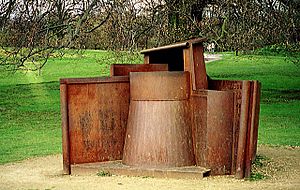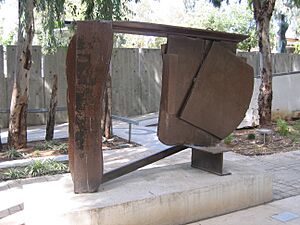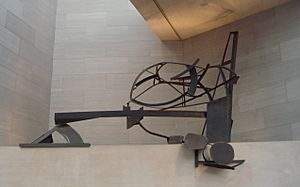Anthony Caro facts for kids
Quick facts for kids
Sir Anthony Caro
|
|
|---|---|
 |
|
| Born |
Anthony Alfred Caro
8 March 1924 New Malden, England
|
| Died | 23 October 2013 (aged 89) London, England
|
| Nationality | British |
| Education | Regent Street Polytechnic |
| Alma mater | Christ's College, Cambridge |
| Known for | Sculpture, drawing |
|
Notable work
|
Twenty Four Hours (1960) Early One Morning (1962) |
| Movement | Constructed steel sculpture, abstract art, modernism |
| Spouse(s) |
Sheila Girling
(m. 1949) |
| Awards | CBE (1969) Knighthood (1987) Order of Merit (2000) |
Sir Anthony Alfred Caro (born March 8, 1924 – died October 23, 2013) was a famous English sculptor. He created amazing abstract art, which means his sculptures didn't look like real things. Instead, they were made from pieces of metal, often using 'found' industrial objects like old beams or plates. He was known as one of the best British sculptors of his time. Early in his career, he even worked with another famous sculptor, Henry Moore.
Contents
Early Life and Learning
Anthony Caro was born in New Malden, England. He was the youngest of three children. When he was three, his family moved to a farm in Churt, Surrey.
He went to Charterhouse School. There, his housemaster helped him meet Charles Wheeler, a sculptor. During school holidays, Caro studied art at the Farnham School of Art. He also worked in Wheeler's art studio.
Later, he studied engineering at Christ's College, Cambridge. After serving in the Royal Navy, he studied sculpture. He went to the Regent Street Polytechnic and then the Royal Academy Schools.
How Anthony Caro Made Art
Anthony Caro learned about modernism when he worked with Henry Moore in the 1950s. Modernism is a style of art that breaks away from traditional ways.
In the early 1960s, he met American sculptor David Smith. After this, Caro stopped making sculptures that looked like real people or objects. Instead, he started building sculptures by welding or bolting together pieces of steel. He used things like I-beams, steel plates, and metal meshes.
One of his first abstract steel sculptures was Twenty Four Hours (1960). This artwork is now at Tate Britain. Often, he would paint his finished sculptures in a bright, flat color.
Sculptures on the Floor
Caro became famous around the world in the late 1950s. He is known for a big change in sculpture: taking it off its stand or 'plinth'. Before him, most sculptures sat on a raised base.
Caro's sculptures usually stand directly on the floor. They support themselves. This change removed a barrier between the art and the person looking at it. It invited people to walk around and interact with the sculpture from all sides.
Workshops for Artists
In 1982, Caro met Robert Loder. Caro was trying to set up an art show in South Africa. In 1981, they came up with an idea for workshops for professional artists. This idea became the Triangle Arts Trust.
They held the first Triangle workshop in 1982. Thirty sculptors and painters from the US, UK, and Canada attended. It took place in Pine Plains, New York.
Later Art Styles
In the 1980s, Caro's art changed again. He started adding more realistic elements. He made a series of figures inspired by classical Greece. After visiting Greece in 1985, he studied old Greek carvings.
He then created large story-telling artworks. One was After Olympia, a huge piece over 75 feet long. It was inspired by the temple to Zeus in Olympia, Greece. Later, he made very large installation pieces. One of these, Sea Music, is on the quay in Poole, Dorset.
In the early 2000s, he made nearly life-size horse figures. These were built from wood and clay pieces. In 2008, Caro opened his "Chapel of Light" in France. He also showed four head sculptures at the National Portrait Gallery in London.
In 2011, the Metropolitan Museum of Art showed five of his works on their rooftop. Around 2012, Caro was working on a huge sculpture. It was planned to cover three blocks of Midtown Park Avenue in New York.
Teaching Art

Caro was also a teacher at Saint Martin's School of Art in London. He inspired many younger British abstract sculptors. Some of his former students and assistants became famous artists themselves. These include Phillip King and Richard Deacon.
In 1966, Caro and some of his former students were asked to join a big art show. It was called Primary Structures at the Jewish Museum in New York. This show highlighted the British influence on "New Art." Caro also taught at Bennington College from 1963 to 1965.
Working with Architects
Caro also worked with famous architects. He teamed up with Frank Gehry to build a wooden village in New York in 1987.
With Norman Foster and engineer Chris Wise, he helped design the London Millennium Footbridge. This bridge crosses the River Thames between St. Paul's Cathedral and the Tate Modern.
Art Shows and Recognition
Since the 1950s, Caro's art has been shown in museums and galleries all over the world. His first solo show was in Milan, Italy, in 1956. His first solo show in London was in 1957.
In 1963, he had another solo show at the Whitechapel Art Gallery. In 2004, to celebrate his 80th birthday, Tate Britain and other galleries held special exhibitions of his work.
Some of his major museum shows include:
- "Anthony Caro: A Retrospective" at the Museum of Modern Art, New York (1975).
- "Anthony Caro" at the Museum of Contemporary Art, Tokyo (1995).
- "Anthony Caro" at Tate Britain, London (2005).
- "Anthony Caro on the Roof" at the Metropolitan Museum of Art, New York (2011).
In 2013, he had an exhibit at the Museo Correr in Venice, Italy. This show was still open when he passed away. His work Veduggio Glimpse is currently on display at Landmarks at The University of Texas at Austin.
Awards and Honors
Anthony Caro was made a knight in 1987. This means he was given the title "Sir." In May 2000, he received the Order of Merit, a very special award.
He won many other prizes too. These include the Praemium Imperiale for Sculpture in Tokyo in 1992. He also received the Lifetime Achievement Award for Sculpture in 1997.
Personal Life and Passing
In 1949, Anthony Caro married the painter Sheila Girling. They had two sons, Timothy and Paul.
Anthony Caro was 89 years old when he died on October 23, 2013. He passed away from a heart attack. Many people praised him after his death. BBC arts editor Will Gompertz called him a "gentle man with a pioneering spirit." Royal Academy of Arts chief executive Charles Saumarez Smith said he was "one of the greatest sculptors in the second half of the twentieth century."
See also
 In Spanish: Anthony Caro para niños
In Spanish: Anthony Caro para niños



